The cost of a solar rooftop or solar panel system can vary depending on a number of factors, such as the size of the system, the type of panels used, the installation costs, and any applicable government incentives or rebates.
Before proceeding to the topic of the cost of Grid Connected Rooftop System you must know the following terms that will help to calculate Rooftop solar cost, rooftop solar cost totally depends on your load capacity.
1) Solar Energy
The energy from the sun can be exploited directly in the form of heat or first converted into electrical energy and then utilized. Accordingly, solar energy is classified in two forms: solar thermal and solar photovoltaics (PV).
- Advantages of Solar PV System
Photovoltaic systems may be a perfect answer for covering basic energy desires of up-to-date and next-generation societies.
- Clean Energy
PV systems use solar energy, a renewable green energy supply, to come up with electricity and so they assist scale back greenhouse emissions and different GHG gas emissions to the atmosphere. Moreover, PV systems, as the other renewable green energy technology, avoid adverse results to the atmosphere that are helpful to the general public health and therefore the surroundings.
- Reliable System
The lifetime of PV systems is anticipated to be 25 to 30 years and might be put in in varied regions and climates wherever exposure to the sun is perfect.
- Safety Factor
The PV systems need daylight to work. It doesn’t need any materials which will combust or explode once lighted , or stay noxious for many years, therefore, makes the PV system safer.
- Reduction in operation prices
PV systems don’t need any fuel for running, rather they need only sunlight that comes at no charge. Additionally, the minimum maintenance is needed therefore reduces maintenance prices.
- Silence Unlike
generators and different sources of power and its generating system, PV makes no noise.
- Modularity
The size and scope of the PV system isn’t fastened. PV systems are scalable and might be expanded at any time to extend the number of power. The growing trend towards electrical converters of standard style the parts are standardised just in case of failure.
- Independence
Because PV systems may be used for remote and little power generation plants, there are a lot of suburbanised and consistent installations that’s less smitten by utility firms. They are conjointly for distributed power generation.
- Sustainable Energy
The PV systems are used for the future even 20-30 years, which offer future energy to the folks, so it’s property energy.
Limitations of PV system
- Initial value high
The value of PV systems is operative is sort of negligible however it needs a higher initial investment cost than those of typical power sources. The PV system produces DC current and voltage therefore needs an electrical inverter and different further devices (e.g. measuring device for Grid Tied PV system) for AC provides that increase the prices of installation of PV system.
- Manufacturing, Storage and Handling
After installation, the PV system is sort of safe however their production, handling and storage come with varied hazards. PV system installer conjointly desires correct coaching in handling the parts.
- Need of Energy Storage Devices
Daylight isn’t continually on the market to power the PV systems, therefore, needs energy devices like batteries to produce a consistent and reliable power supply. The batteries and different devices increase the price.
- Efficient system
The potency of photovoltaic cells has improved and it’s still in the range of 14 to 40 percent. That is far from the opposite sources of power. Its unskillfulness, a lot of solar energy is needed to work the same device.
- Inconsistent supply of energy
Sun doesn’t continually shine in the daytime. Additionally to the current, geographic location, climate and different environmental conditions have an effect on the number of exposure to any on-the-market daylight. so it creates an inconsistent supply of energy.
- Lack of Awareness
With a lot of technology and its data, a lot of power can receive society from the sun in a reasonable and sensible approach. The dearth of information slows the expansion of different energy markets similar as PV systems.
How Does the Rooftop Solar System Work?
These are ideal conditions for the sun’s energy to convert it into electric power. This thing can be done by adding an interface device known as an inverter to convert the DC power generated by the solar panels on the rooftop to AC power because most appliances/devices run on AC.
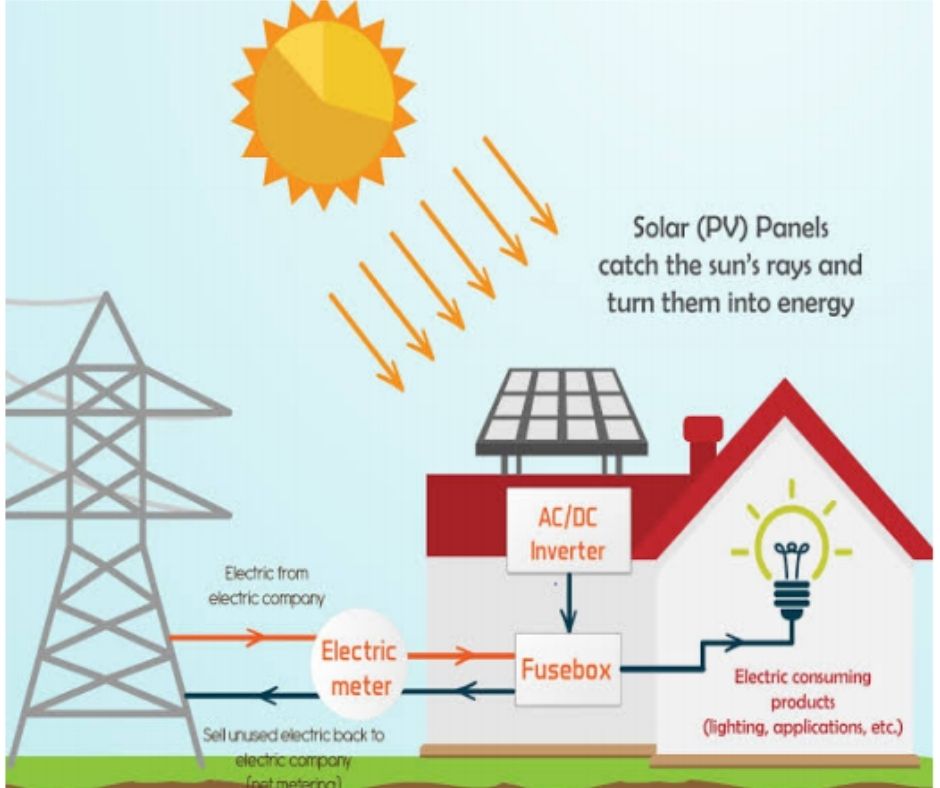
2) Photovoltaic Module
- Basic Principle of PV Effect: Solar Cells are those devices, which convert solar energy directly into electricity. The most common form of solar cells is based on the photovoltaic (PV) effect in which light falling on a two-layer semiconductor device produces a photovoltage or potential difference between the layers. This voltage is capable of driving a current through an external circuit and thereby producing useful work.
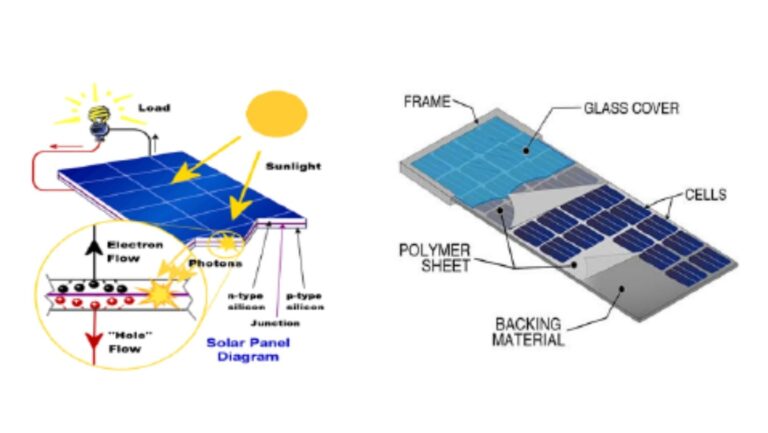
Types of Solar Modules: There are three main types of Solar Modules they are as follow;
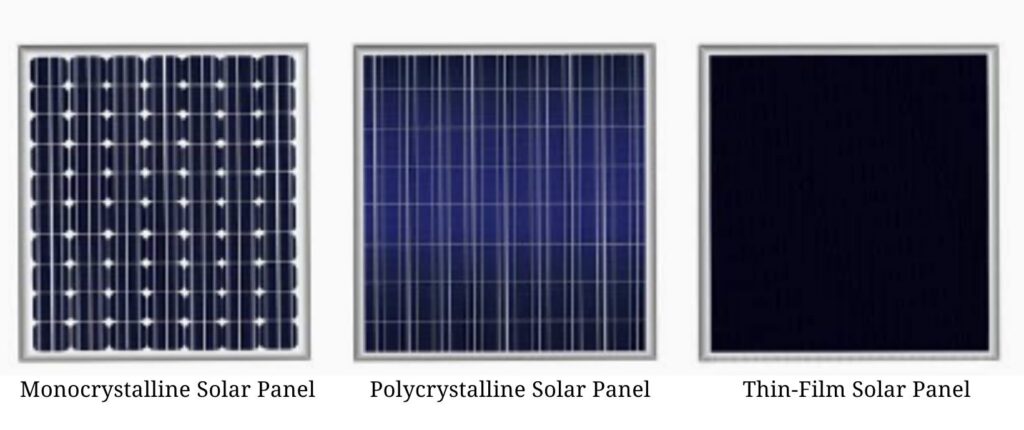
| Mono-crystalline Silicon | 20% |
| Poly-crystalline Silicon | 15% |
| Amorphous(Thin-film) | 7- 10 % |
Technology Module Efficiency
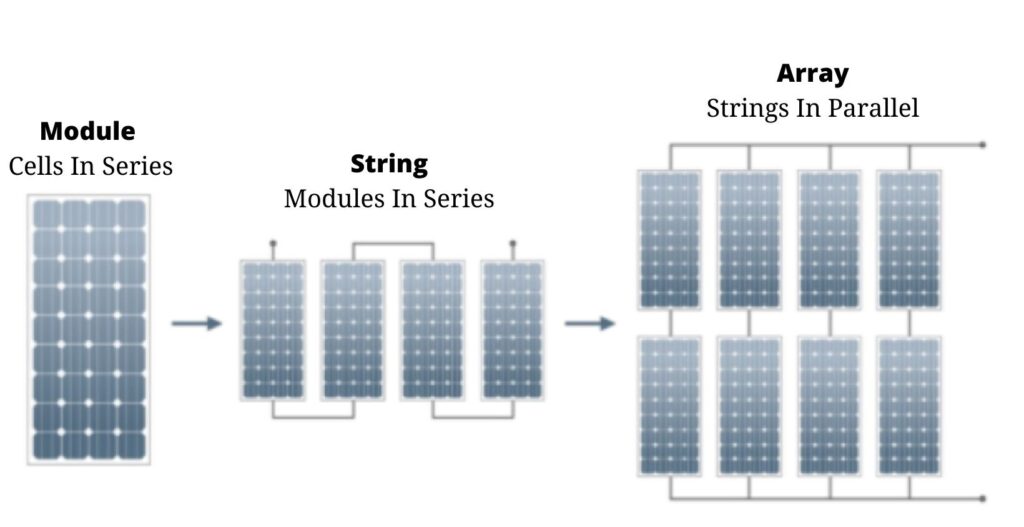
3) Solar PV Rooftop System Design & Architecture:
Solar PV Rooftop System Components;
The photovoltaic system components include all those components which are necessary for the transformation of light energy to electrical energy. The form of electrical energy is either an AC or DC system. The PV system components are:
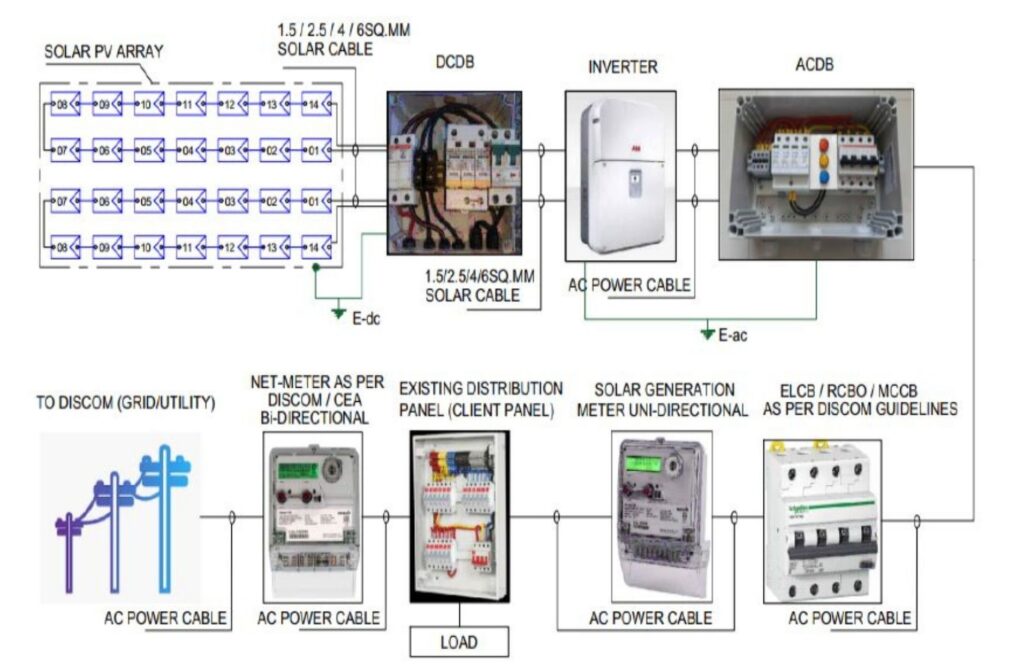
Module: The module is the integration of PV cells. When the PV cells are connected in an organized design form that provides electric power in a PV system it is called a module. When there is one or more than one module then it is referred to as a panel. The PV cells are laminated between two layers.
Array: This is a combination of one or more panels combined together to produce specified voltage and current with specific power then it is called an array. Array contains modules but modules do not include the array.
DCDB: It controls the DC power from Solar Panels and provides necessary overcurrent protection (fuse, MCB), and surge protection device (SPD) for over-voltage protection for the protection of the solar panel’s strings and solar inverter from any type of damage. While we design the project we will have to select the DCDBs considering the project string configuration & DC inputs available on Inverter to connect PV Module String. DCDBs will come along with different combinations:
-1 in 1 out
-2 in 2/1 out
-4 in 4/2/1 out (you can select it as per your project requirements)
Inverter: Solar Inverter/Power Inverter (Heart of Solar Power) is the electrical device that converts the DC signals of voltage and current to AC signals of voltage and current. The array produces DC which is used to charge the battery and lastly converted to AC by means of an inverter.
ACDB: The ACDB receives the AC power from the solar inverter and directs it to AC loads through the distribution board. ACDB includes a necessary surge protection device (SPD) and MCCB to protect the solar inverter from any type of damage or heavy voltage. Specifications of ACDB may change as per the load or inverter capacity.
Solar Generation Meter-Unidirectional: These meters usually measure power and this meter is Unidirectional.
Existing Distribution Board (AC loads): It is a component of an electricity supply system that divides an electrical power feed into subsidiary circuits while providing a protective fuse or circuit breaker.
Net Metering-Bidirectional: Net metering is an electricity billing mechanism that allows consumers who generate some or all of their own electricity to that electricity anytime, instead of when it is generated. The meter can measure the flow of electricity in two directions.
- Module layout & Module Connection Details:
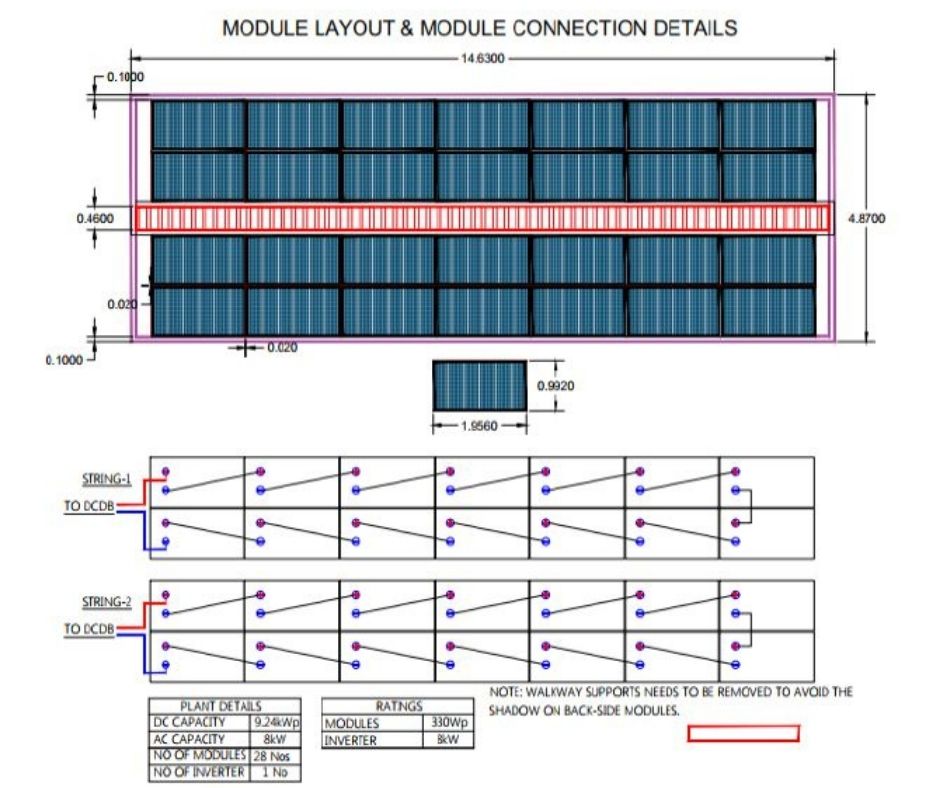
4) Photovoltaic Inverters:

- Types of Solar Inverters:
String Inverter: They are directly connected to the grid and mostly do not come with the facility of battery backup. Most commonly used for both business and household purposes. They generally have 25 years of design lifelong with a 5-year warranty.
- Reliable Technology
- Available 3 options for phase
- Highly efficient
- Low power consumption
- String inverters are small inverters in the 1 to 12kW size range, intended for residential and small commercial sectors.
5) Balance of Solar PV System(BOS):
It includes all components of a PV system other than the PV panels. List of BOS are as
follows;
- ACDB/DCDB
- AC/DC Cable
- Lightning Arrester
- MC4 Connectors
- Insulation Tape
- Earthing Wire
- Lugs & Glands
- SPD
- Cable ties & Trays
- Conduit Pipes
- Flexible Conduit Pipe
- Metal screw with grip
- Module Mounting Structure(MMS)
6) Rooftop PV System Design & calculations:
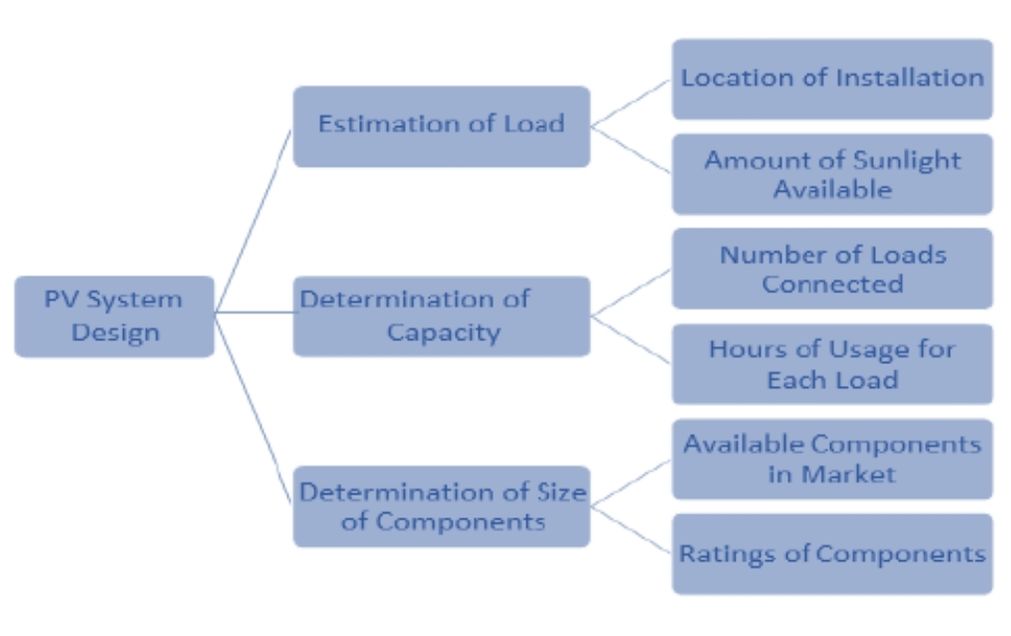
Technical Specification:
The following parameters shall be clearly specified by the manufacturer for different type of solar modules manufactured by Company:
a) Peak power output (Pm)
b) Current at peak power output (Im)
c) Voltage at peak power output (Vm)
d) Short circuit current (Isc)
e) Open circuit voltage (Voc)
f) Conversion efficiency the module (n)
The values of parameters from (a) to (f) above shall be specified under standard test conditions of
The cell junction temperature of 25 ± 2ºC.
Irradiance of 1000 Watt/sq.mm. as measured with a reference solar cell.
Standard Solar spectral energy distribution.
Air Mass of 1.5.
Example: Design Rooftop Solar System for a 3kW System with Cost.
(All calculations & their selected specifications depend on your sanctioned load capacity)
Steps to be followed:
Step 1: Residential System 3kW (Single Phase,230V)
3kW=3000 Watt
3000*1.2= 3600 Watt (Considering Overloading Condition Multiplying Factor 1.2)
Step 2: Inverter Rating(AC) 3kW (Sanctioned Load mentioned on
Electricity Bill)
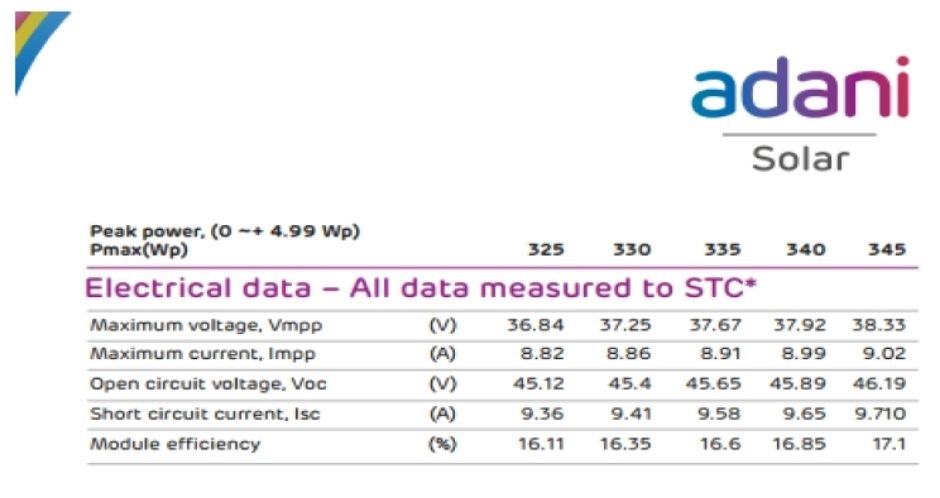
Step 3: Calculate No. of PV Module Required (3600Wp DC Capacity)
No. of modules= 3600/330
=11 Module
(Type of module selection depends on the consumer according to their cost estimation & requirement of project or market availability)
Step 4: Inverter(3kW)
String Configuration 11 modules are connected in series (Referring to Growatt Inverter Datasheet No. of independent MPPT trackers/strings per MPPT=1/1)
11 Modules= (Vmpp=37.25 V) (Referring to Adani datasheet)
Condition 1: To Check Voc Limit (Module datasheet)
Voc=45.4V
45.4*11(No. of modules) =498.3V
(Within Maximum DC voltage of Inverter from Datasheet i.e. 550V)
Condition 2: To Check Maximum Input Current (Inverter datasheet)
The maximum input current of inverter= 13A
Impp=8.86A (Module datasheet)
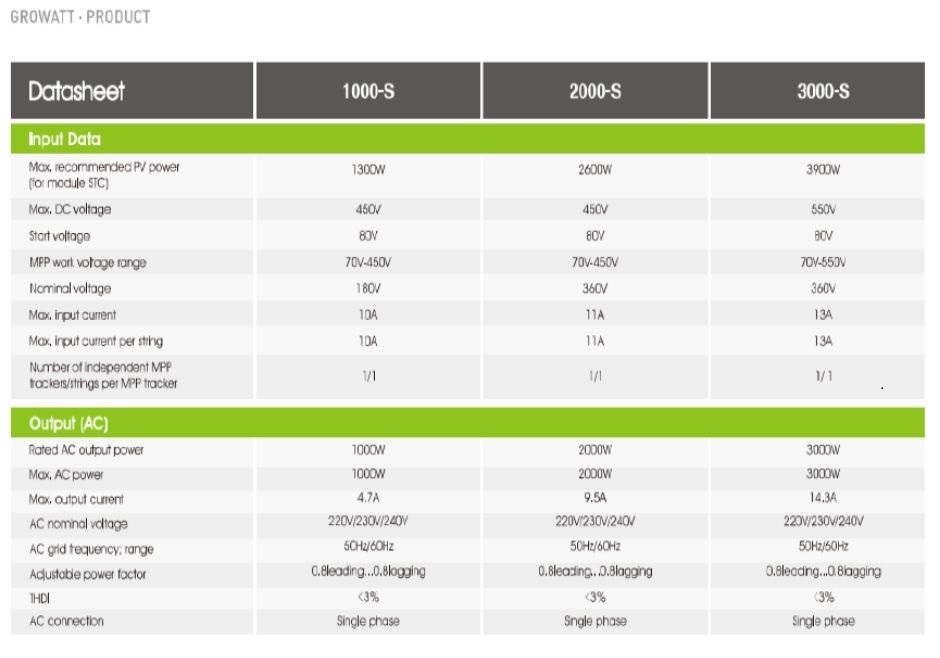
Step 5: DC Cable specification
4sq.mm Single core cable for string connection
Step 5: Inverter Output Current (Inverter Datasheet)
Inverter o/p Current=14.3*1.25= 17.87A (Considering over current condition)
LT Cable 1000V (Standard for residential 1ph 2 core cable required)
4 sq. mm cable=44A (As per Polycab wires & cable catalogs)
Step 6: Selection of ACDB (Includes MCB & SPD) (As per market availability with standard current ratings)
Step 7: Selection of MC4 Connectors (As per market availability & size depend on the area of installation of the plant)
Step 8: Selection of Generation Meter (As per market availability)
(ACDB Cable Generation meter to existing Distribution Board)
Step 9: Selection of Net Meter (As per market availability)
Step 10: Balance of PV System (Required Accessories of PV System)
Cost Calculation of Solar Rooftop System:
(Cost is depending on size & selection of components & makes you used as per your requirement)
| 1 | Solar PV Module 330Wp rating(11 Module) | 90,000 |
| 2 | 3kW grid tie Inverter | 25,000 |
| 3 | Mounting Structure(1 lot) | 20,000 |
| 4 | AC/DC cable | 5,000 |
| 5 | AC/DC Junction box | 12,000 |
| 6 | MC4 Male/Female Connectors | 1,000 |
| 7 | 25mm diameter PVC pipe (with all connected accessories) | 2,000 |
| 8 | Generation Meter | 7,000 |
| 9 | Bi-directional electronic Energy mete r(Net Metering) | 15,000 |
| 10 | Earthing Kit, Lightning arrester Insulation Tape, Lungs & Glands, Metal screw with grips etc. (with all connected Solar accessories) | 20,000 |
| 11 | Civil work (Subjected size condition) | 20,000 |
| 12 | Total Cost: | 2,17,000/- |
Note: Cost to install a 1kW Solar Residential Rooftop System Can Range from 45000/- to 85000/- in India


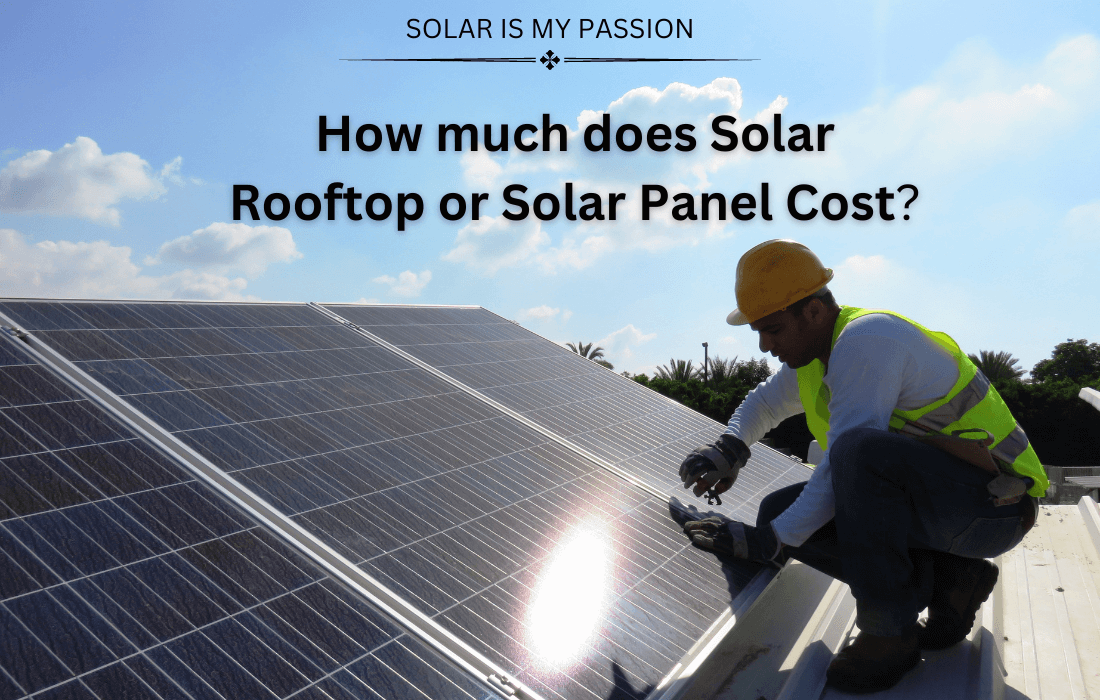
Hi…
We wish to install Solor System for our Farm house in Pune…
Bharat Ketkar
9820471888
Contact Sachin Jagtap (Sailee Electrical and solar systems)
9011690714